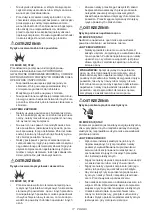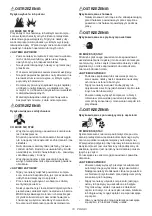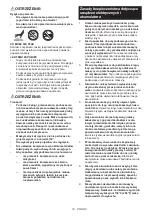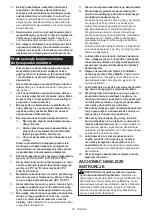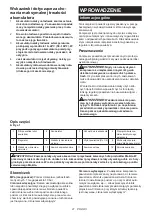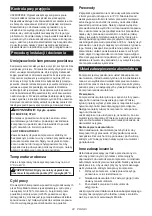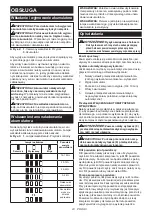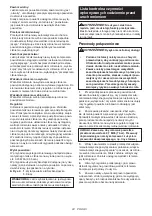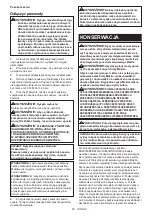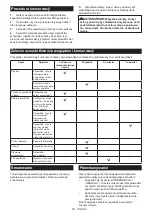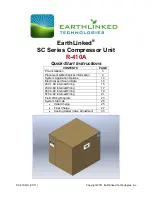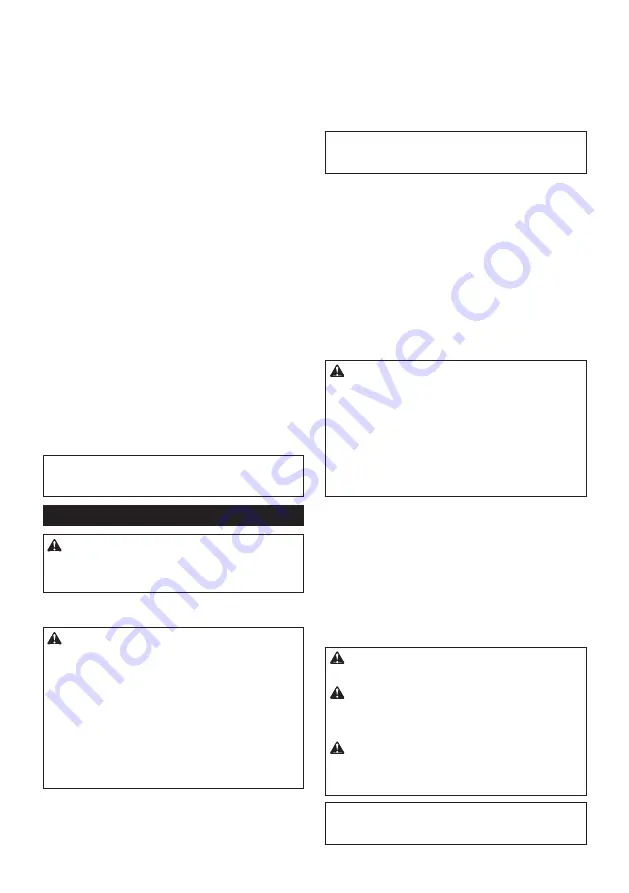
11 ENGLISH
Safety valve:
If the pressure switch does not shut off the air compres
-
sor at its “cut-out” pressure setting, the safety valve
will protect against high pressure by “popping out” at
its factory set pressure which is slightly higher than the
pressure switch “cut-out” setting.
Outlet pressure gauge:
The outlet pressure gauge indicates the air pressure
available at the outlet side of the regulator. This pres-
sure is controlled by the regulator and is always less or
equal to the tank pressure.
Tank pressure gauge:
The tank pressure gauge indicates the air pressure in
the tank.
Regulator:
The air pressure coming from the air tank is controlled
by the regulator knob. Turn the knob clockwise to
increase pressure and counter-clockwise to decrease
pressure. To avoid minor re-adjustment after making
a change in pressure setting, always approach the
desired pressure from a lower pressure. When reducing
from a higher to a lower setting, first reduce to some
pressure less than desired pressure. Depending on the
air requirements of each particular accessory, the outlet
regulated air pressure may have to be adjusted while
you are operating the accessory.
Air outlet:
For regular pressure pneumatic tool, use outlet max
pressure; 0.93 MPa (9.3 bar).
When using a quick coupler in the market, install it to
the air outlet using the two wrenches as shown in the
figure.
►
Fig.4:
1.
Air outlet
2.
Quick coupler
3.
Wrench
NOTE:
If the quick coupler does not have any air
sealing method, we recommend applying an ade-
quate measure such as a sealing tape.
Daily Start-up Checklist
WARNING:
Do not use the power tool if the
switch does not turn it on and off.
Any power tool
that cannot be controlled with the switch is dangerous
and must be repaired.
Connecting hoses
WARNING:
Risk of Unsafe Operation
•
Firmly grasp hose in hand when installing
to prevent hose whip. Losing control of the
hose may result in personal injury and prop-
erty damage.
•
Always follow all safety rules recommended
by the manufacturer of hoses, connectors,
air tools, and accessories in addition to
all safety rules for the air compressor.
Following this rule will reduce the risk of
serious personal injury.
1.
Before attaching air hose or accessories, make
sure On/Auto-Off switch lever is set to “Off”, the battery is
removed, and the air regulator or shut-off valve is closed.
2.
Attach hose and accessories. Too much air pres-
sure causes a hazardous risk of bursting. Check the
manufacturer’s maximum pressure rating for air tools
and accessories. The regulator outlet pressure must
never exceed the maximum pressure rating.
NOTICE:
Air pressures above 0.7 MPa (7 bar)
is recommended. The delivery hoses should be
fitted with a safety cord such as wire rope.
3.
Install the battery cartridge and turn the On/Auto -
Off switch to “On/Auto” and allow tank pressure to build.
Motor will stop when tank pressure reaches “cut-out”
pressure.
4.
Open the regulator by turning it clockwise. Adjust
the regulator to the correct pressure setting. Your com-
pressor is ready for use.
5.
Always operate the air compressor in well-venti-
lated areas; free of gasoline or other solvent vapors. Do
not operate the compressor near the spray area.
When you are finished:
Disconnecting hoses
WARNING:
Risk of Unsafe Operation
•
Firmly grasp hose in hand when disconnect-
ing to prevent hose whip. Losing control of
the hose may result in personal injury and
property damage.
•
Air tanks contain high pressure air. Keep
face and other body parts away from out-
let of drain. Always wear approved safety
glasses with side shields when draining as
debris can be kicked up into face.
1.
Set the On/Auto - Off switch to “Off” and remove
the battery cartridge.
2.
Turn the regulator counterclockwise to set the
outlet pressure to zero.
3.
Remove the air tool or accessory.
4.
Open the drain valve located at the lower part of
the air tank. Tank pressure should be below 0.14 MPa
(1.4 bar) when drain the air tank.
5.
Tilt the tank so that the drain valve is directly
below and drain.
WARNING:
Risk of bursting
Tilt tank to drain.
WARNING:
To drain tank, open the drain
valve slowly and tilt compressor to empty accu-
mulated water. Keep face and eyes away from the
drain valve.
WARNING:
WATER WILL CONDENSE
IN THE AIR TANK. IF NOT DRAINED, WATER
WILL CORRODE AND WEAKEN THE AIR TANK
CAUSING A RISK OF AIR TANK RUPTURE.
NOTICE:
Risk of Property Damage
Always drain water from the air tank. The water
may contain oil and rust which can cause stains.

















